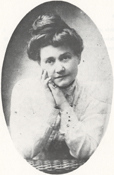 This Goodly Land
This Goodly Land
Martha Young (January 11, 1862–May 9, 1941)

Other Names Used
- Martha Strudwick Young: full name
- Eli Sheppard: pen name
Alabama Connections
- Newbern, Hale County: birthplace, early childhood residence
- Greensboro, Hale County: childhood residence, education, adult residence, place of burial
- Havana, Hale County: education
- Tuscaloosa, Tuscaloosa County: education
- Livingston, Sumter County: education
Selected Works
- Sheppard, Eli. Plantation Songs for My Lady's Banjo: And Other Negro Lyrics and Monologues. Illus. J. W. Otis. New York: R. H. Russell, 1901. An online version of Plantation Songs for My Lady's Banjo is available from Google Book Search.
- Young, Martha. Plantation Bird Legends. Illus. J. M. Conde. New York: R. H. Russell, 1902. Rpt. Freeport, N.Y.: Books for Libraries Press, 1971. An online version of Plantation Bird Legends is available from Google Book Search.
- Young, Martha. Bessie Bell. Illus. Ida Dougherty. New York: Scott-Thaw Co.,, 1903. Rpt. as Somebody's Little Girl. New York: Hinds, Noble & Eldredge, 1910. An online version of Somebody's Little Girl is available from Project Gutenburg. For younger readers.
- Young, Martha. Behind the Dark Pines. Illus. J. M. Conde. New York: D. Appleton, 1912. Rpt. Freeport, N.Y.: Books for Libraries Press, 1972. An online version of Behind the Dark Pines is available from Internet Archive's American Libraries.
Biographical Information
Martha Young was born on her family’s plantation near Newbern, Ala. When she was about six, the family moved to Greensboro, Ala. Young attended the Greensboro Female Academy, where two of her teachers were Louise Clarke Pyrnelle and her aunt Julia Strudwick Tutwiler. Later, she attended Greene Springs School (owned and operated by her grandfather, Henry Tutwiler), Tuscaloosa Female Academy, and Livingston Female Academy (now the University of West Alabama). Young graduated from Livingston in 1880 and returned to her family home. In Greensboro, she cared for her father and siblings and speculated in real estate. Young also began writing down the black dialect stories and songs which had interested her since childhood.
Young’s first story, “A Nurse’s Tale,” appeared in the New Orleans Times-Democrat in 1884. Her stories, poems, and essays were published in other newspapers and in magazines such as Cosmopolitan and The Century Magazine. Young’s dialect stories were popular and were compared to the work of Joel Chandler Harris, creator of “Uncle Remus.” Her first two books, Plantation Songs for My Lady’s Banjo and Plantation Bird Legends, were published in 1901 and 1902, respectively. At this point, Young began writing stories for children as well. Her first children’s book was Bessie Bell, published in 1903. In addition to her writing, Young began giving public readings of her work, which she continued to do for several decades. Her last book was published in 1921. In the last two decades of her life, Young wrote and published poems on religious and sentimental subjects.
Interests and Themes
Martha Young recorded and published folk songs and stories in black dialect. She also wrote stories for children, nonfiction essays, and poetry.
For More Information
Please check your local library for these materials. If items are not available locally, your librarian can help you borrow them through the InterLibrary Loan program. Your librarian can also help you find other information about this author.
There may be more information available through the databases in the Alabama Virtual Library. If you are an Alabama citizen, AVL can be used at your public library or school library media center. You can also get a username and password from your librarian to use AVL at home.
Reference Books
- Hoole, William Stanley. Martha Young: Alabama's Foremost Folklorist. University, Ala.: Confederate Publishing Company, 1982.
Reference Articles
- Windham, Ben. "Writer Rediscovered After Falling into Disfavor". Tuscaloosa News 11 July. 2005: n. pag.
Location of Papers
- University of Alabama
- University of West Alabama
Photo from Martha Young, Alabama's Foremost Folklorist, 1982.
Last updated on May 30, 2008.